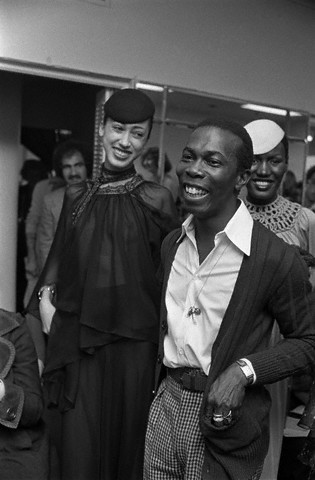
Nelson Clyde Barr
About
Scott Barrie (born Nelson Clyde Barr) was one of a group of brassy and vibrant black designers and models to establish themselves on New York's Seventh Avenue in the late 1960s.
Nelson Clyde Barr was born in Philadelphia in January 1946. He studied Applied Arts at the Philadelphia Museum College of Art and Fashion Design at the Mayer School of Fashion in New York, graduating 1965.
He took the new name of Scott Barrie when he started his fashion career.
He was influenced by his godmother who had designed clothes for the jazz singers Dinah Washington and Sarah Vaughan. His mother did not initially encourage him because she felt a black man would not have a future in fashion designing, but Scott proved her wrong.
His first job was with the Allen Cole boutique, New York from 1966 to 1969. From 1969 to 1982 he ran his own concern Barrie Sport in New York, in between introducing Barrie Plus Collections in 1974.
He began making clothes at home on his cutting table and home sewing machine. First orders came from small boutiques, but when Henri Bendel and Bloomingdales ordered his sexy jersey dresses, he became more well-known and could move into a spacious workroom on 7th Avenue.
Alongside his own label, Scott designed for S.E.L., made loungewear for Barad and furs for Barlan.
In 1982, he moved to Milan, Italy and formed Scott Barrie Italy, in partnership with Kinshido Company of Japan. From 1983 to 1991 he was the designer for the Milan D'Or division of Kinshido. From 1986 to 1988 Barrie designed free-lance for Krizia, Milan.
Scott Barrie was one of a group of vibrant black designers including Willi Smith, Stephen Burrows, Patrick Kelly, and Jon Haggins who established themselves on New York's 7th Avenue in the 1970's and 1980's.
Their creative energy really stimulated the world of fashion.
His forte was the sensuous use of jersey, cut in inventive and unexpected ways, making elegant and sexy evening wear. Many of the successful black models like Naomi Sims, loved his clothes.
Scott also created costumes for films and the theatre, particularly for Jeffrey Ballet's production of "Deuce Coupe".
He died quite young, in Alessandria, Italy, in June 1993 at the age of 47.
The Look
The intermingling of culture and race on New York's Seventh Avenue in the 1960s brought a new sort of creative energy that challenged accepted standards. Barrie's models did not parade the catwalk with elegance; instead they boogied wildly and arrogantly, with a streetwise brashness. It was a testimony to the changing times that the clothes were accepted at the higher end of the ready-to-wear market. Describing himself in the 1970s as being midway between the crazy extremes of Zandra Rhodes and Herbert Kasper, Barrie quickly established himself as a designer of sexy, often outrageous clothes. His eveningwear was particularly noteworthy: skinny gowns sprinkled with pailettes and dangerously high splits, or jersey slips that slid tantalizingly over the figure. His innovative clothes included use of Acrilan, Celanese acetate knit, Jasco matte jersey and Lurex. He made emsembles of pull-on T-shirts with pants, wrap min dresses, décolleté shirt-tunic dresses laced down the front with cords or chains, long halter dresses, and elasticized pull-on strapless jumpsuits. Barrie's forté was the sensuous use of jersey, cut in inventive and unexpected ways, from which he created elegant and often risqué eveningwear.